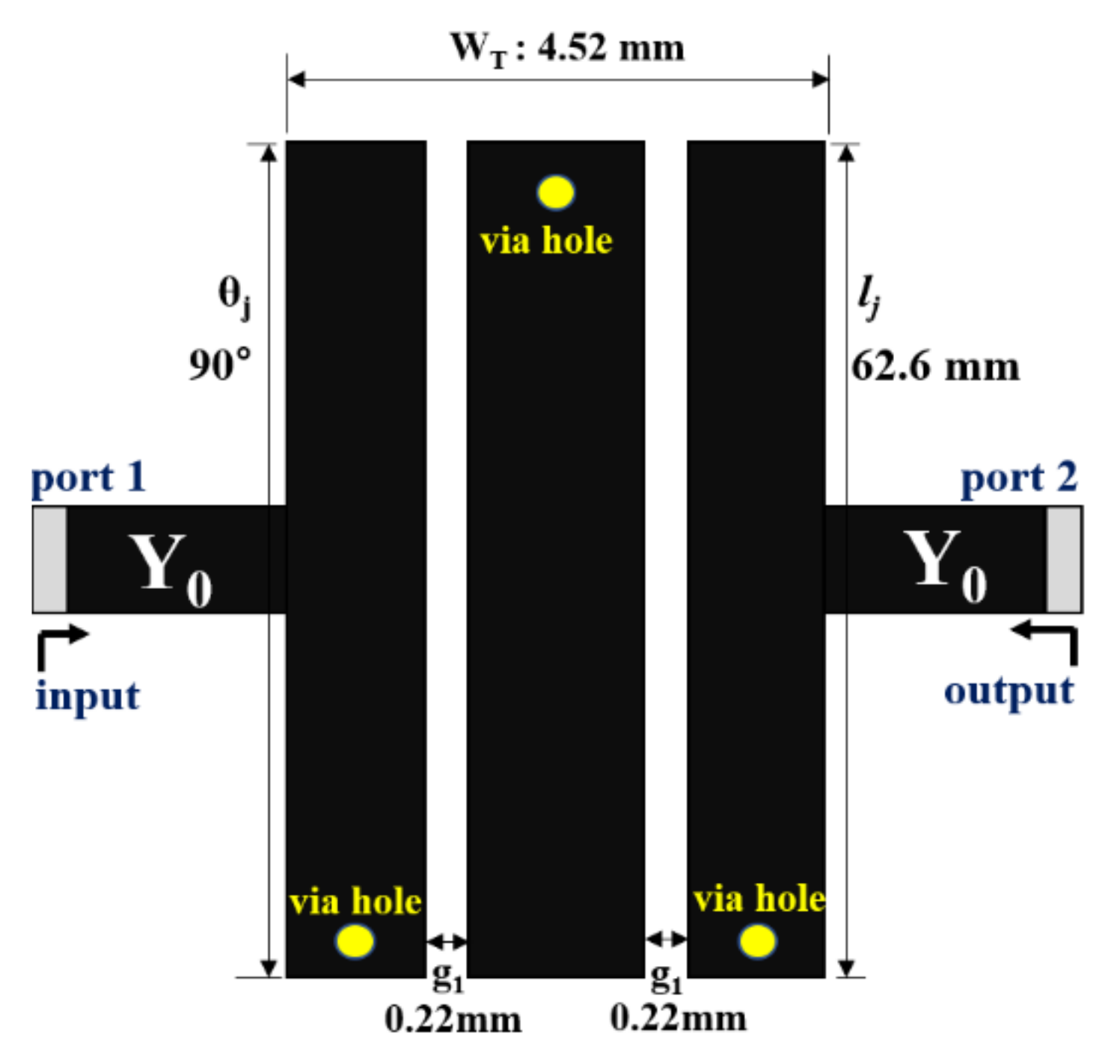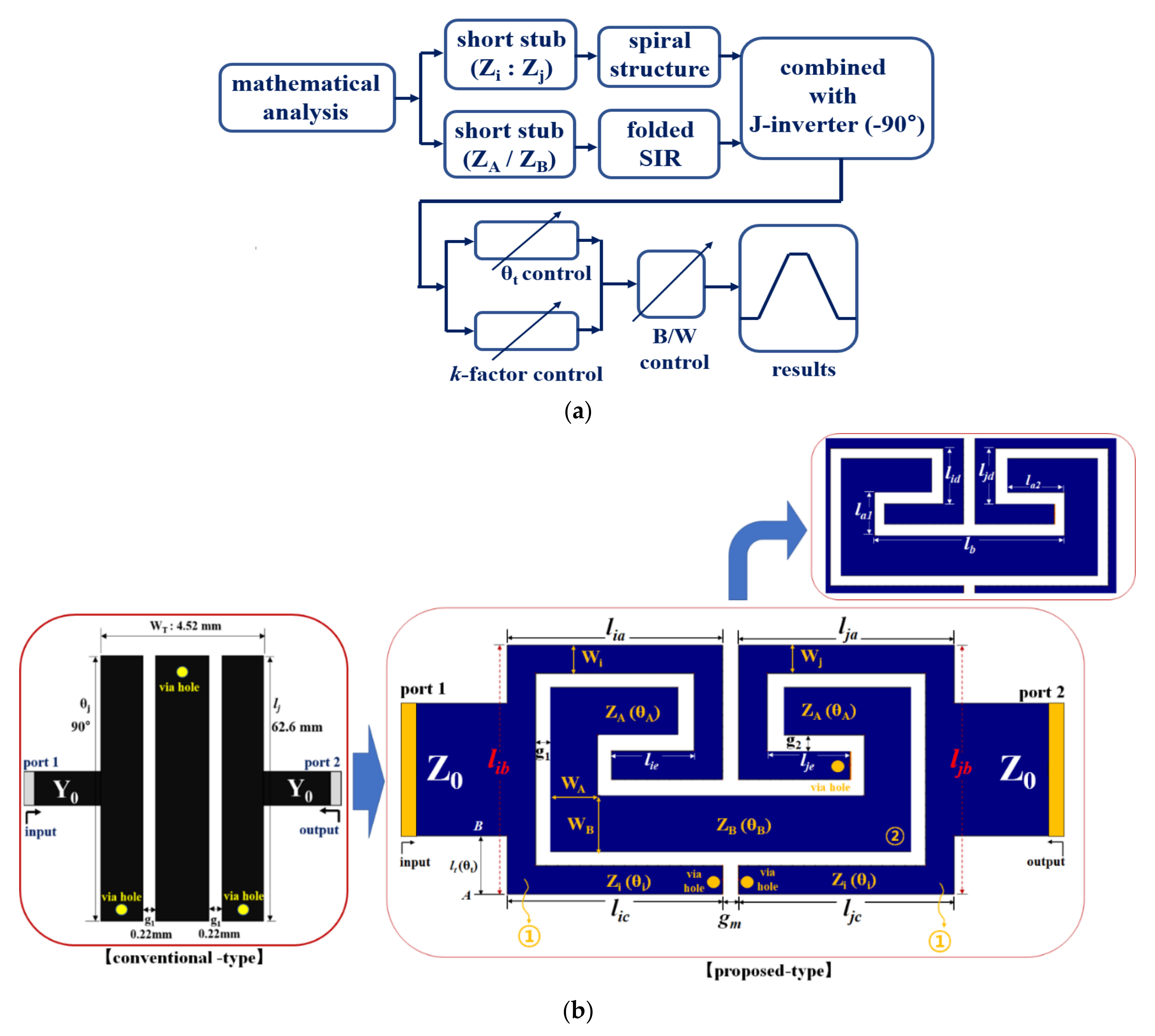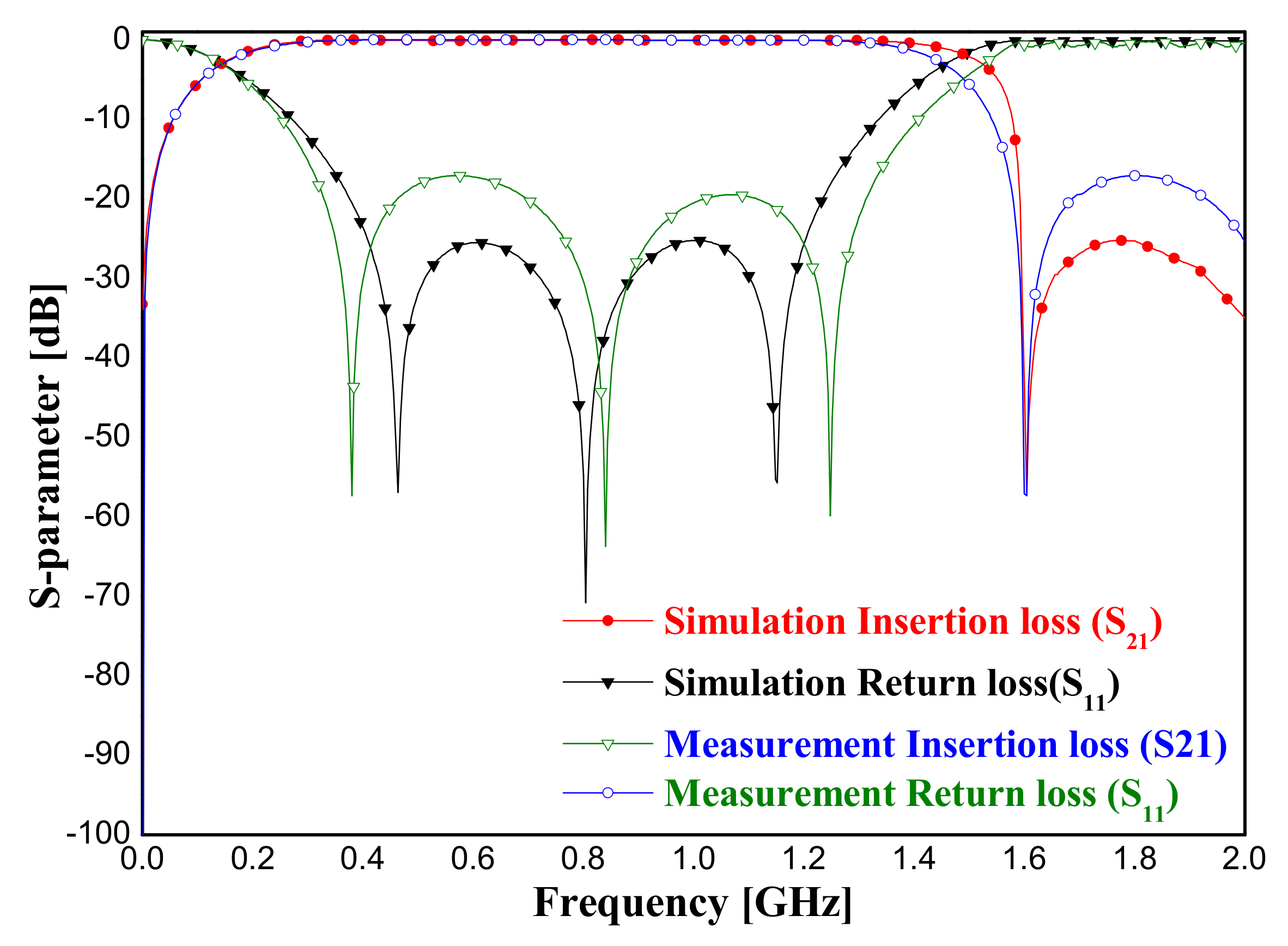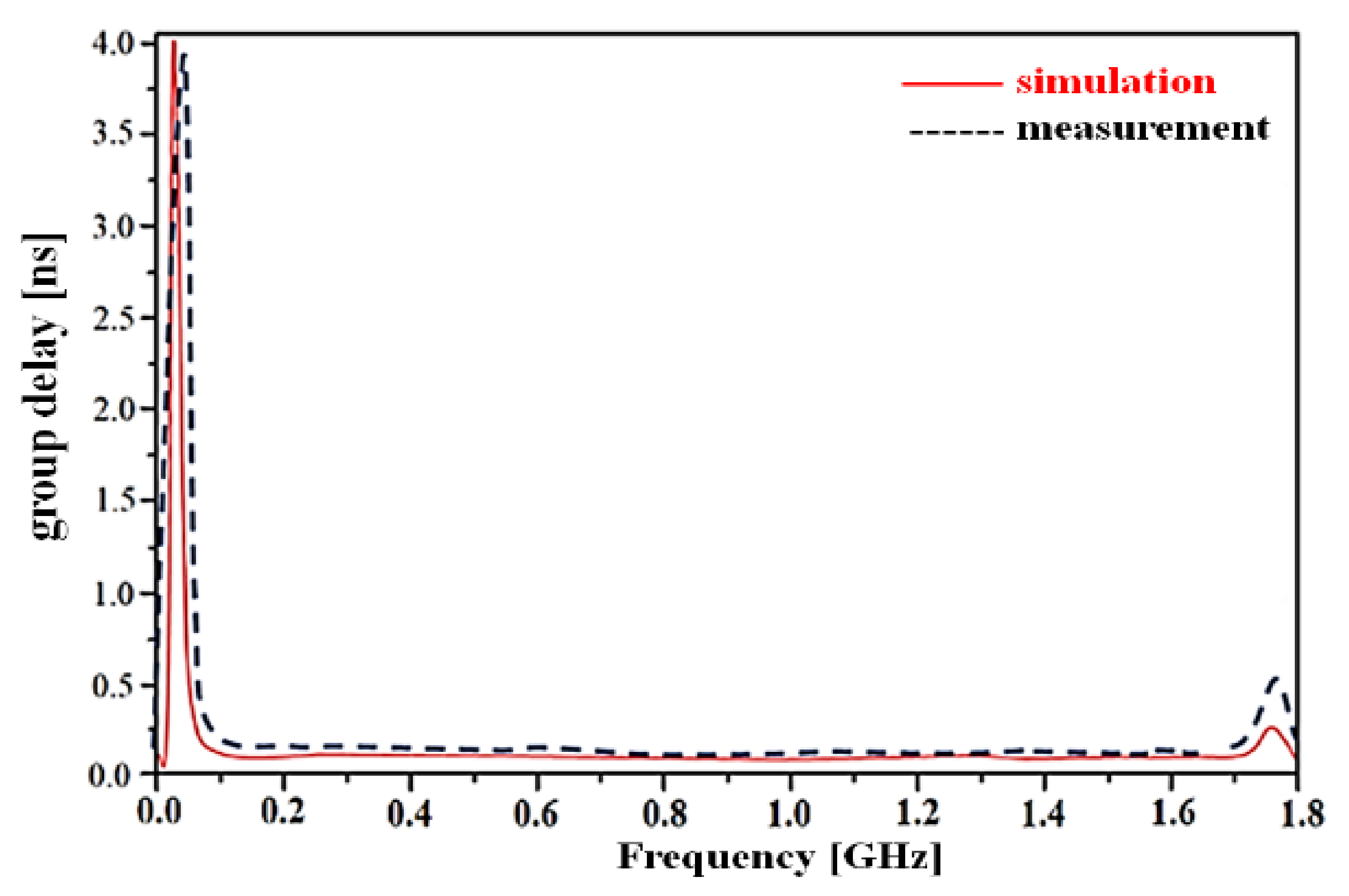Compact Size of an Interdigital Band-Pass Filter with Flexible Bandwidth and Low Insertion-Loss Using a Folded Spiral and Stepped Impedance Resonant Structure
Abstract
:1. Introduction
2. Analysis of an Interdigital Bandpass Filter
2.1. Conventional Bandpass Filter
2.2. Proposed Bandpass Filter
3. Fabrication and Experimental Results
4. Discussion
5. Conclusions
Author Contributions
Funding
Institutional Review Board Statement
Informed Consent Statement
Data Availability Statement
Acknowledgments
Conflicts of Interest
References
- Oke, A.; Fernandes, F.A.P. Innovations in teaching and learning: Exploring the perceptions of the education sector on the 4th industrial revolution (4IR). J. Open Innov. Technol. Mark. Complex. 2020, 6, 31. [Google Scholar] [CrossRef]
- Hong, J.S.; Lancaster, M.J. Microstrip Filters for RF/Microwave Applications; John Wiley & Sons Inc.: Hoboken, NJ, USA, 2001. [Google Scholar]
- Almorqi, S.; Shaman, H.; Alamoudi, A. Parallel−coupled stub−loaded resonator bandpass filter with ultra−wideband passband on multilayer liquid crystal polymer substrates. Int. J. Microw. Wirel. Technol. 2016, 8, 1183–1186. [Google Scholar] [CrossRef]
- Shaman, H.; Almorqi, S.; Al Amoudi, A. Ultra−wideband (UWB) Bandpass Filter with Cascaded Lowpass Filter on Multilayer Liquid−Crystal Polymer (LCP) Substrate. IETE J. Res. 2016, 62, 63–67. [Google Scholar] [CrossRef]
- Cristal, E.G.; Fankel, S. Hairpin−line and hybrid hairpin−line/half−wave parallel−coupled−line filters. IEEE Trans. Microw. Theory Tech. 1972, 20, 719–728. [Google Scholar] [CrossRef]
- Wong, J.S. Microstrip tapped−line filter design. IEEE Trans. Microw. Theory Tech. 1970, 27, 44–50. [Google Scholar] [CrossRef]
- Matthaei, G.L.; Young, L.T.; Jones, E.M. Microwave Filters, Impedance Matching Networks, and Coupling Structures; McGraw−Hil: New York, NY, USA, 1964. [Google Scholar]
- Mattaei, G.L. Interdigital band−pass filters. IEEE Trans. Microw. Theory Tech. 1962, 10, 479–491. [Google Scholar] [CrossRef]
- Xiang, K.R.; Chen, F.C. Compact microstrip bandpass filter with multispurious suppression using quarter−wavelength and half−wavelength uniform impedance resonators. IEEE Access 2018, 6, 20364–20370. [Google Scholar] [CrossRef]
- Moattari, A.M.; Karimi, G.H. Compact NB BPF is using modified slow wave resonator with wide upper stopband. Microw. Opt. Technol. Lett. 2016, 58, 616–619. [Google Scholar] [CrossRef]
- Singh, P.K.; Tiwary, A.K.; Gupta, N. Ultra−compact switchable microstrip band−pass filter−low−pass filter with improved characteristics. Microw. Opt. Technol. Lett. 2017, 59, 197–201. [Google Scholar] [CrossRef]
- Orellana, M.; Selga, J.; Vélez, P.; Sans, M.; Boria, V.E.; Martín, F. Design of capacitively loaded coupled−line bandpass filters with compact size and spurious suppression. IEEE Trans. Microw. Theory Tech. 2017, 65, 1235–1248. [Google Scholar] [CrossRef]
- Cidronali, A.; Collodi, G.; Maddio, S.; Pelosi, G.; Selleri, S. Quasi−elliptical band−pass filters based on compact spiral resonators for C−band applications. Microw. Opt. Technol. Lett. 2019, 61, 1983–1987. [Google Scholar] [CrossRef]
- Mu, Y.; Ma, Z.; Xu, D. A novel compact interdigital bandpass filter using multilayer cross−coupled folded quarter−wavelength resonators. IEEE Microw. Wirel. Compon. Lett. 2005, 15, 847–849. [Google Scholar]
- Feng, W.; Che, W.; Xue, Q. Compact−ultra−wideband bandpass filters with narrow notched bands based on a ring resonator. IET Microw. Antennas Propag. 2013, 7, 961–969. [Google Scholar] [CrossRef]
- Feng, W.; Che, W. Novel wideband differential bandpass filters based on T−shaped structure. IEEE Trans. Microw. Theory Tech. 2012, 60, 1560–1568. [Google Scholar] [CrossRef]
- Huang, F.; Wang, J.; Hong, J.; Wu, W. Wideband balun bandpass filter with broadside−coupled microstrip/slotline resonator structure. IET Electron. Lett. 2017, 53, 1320–1321. [Google Scholar] [CrossRef]
- Qiu, F.C.C.J.; Chen, Z.H.; Chu, Q.Q.X. Low insertion loss wideband bandpass filter with six transmission zeros. IET Electron. Lett. 2013, 49, 477–479. [Google Scholar]
- Zhou, C.X.; Guo, P.P.; Zhou, K.; Wu, W. Design of a compact UWB filter with high selectivity and superwide stopband. IEEE Microw. Wirel. Compon. Lett. 2017, 27, 636–638. [Google Scholar] [CrossRef]
- Lan, S.W.; Weng, M.H.; Hung, C.Y.; Chang, S.J. Design of a compact ultra−wideband bandpass filter with an extremely broad stopband region. IEEE Microw. Wirel. Compon. Lett. 2016, 26, 392–394. [Google Scholar] [CrossRef]
- Sheikhi, A.; Alipour, A.; Mir, A. Design and fabrication of an ultra−wide stopband compact bandpass filter. IEEE Trans. Circuits Syst. II Express Briefs 2020, 7, 265–269. [Google Scholar] [CrossRef]
- Huang, C.C.; Fang, W.T.; Lin, Y.S. Miniaturization of broadband stub bandpass filters using bridged−T coils. IEEE Access 2018, 6, 20164–20173. [Google Scholar] [CrossRef]
- Gomez−Garcia, R.; Alonso, J.I. Design of sharp rejection and low−loss wide−band planar filter using signal−interference techniques. Microw. Wirel. Compon. Lett. 2005, 15, 530–532. [Google Scholar] [CrossRef]
- Suh, B.; Lee, H.; Kim, S.; Jeon, S. A D−band multiplierbased OOK transceiver with supplementary transistor modeling in 65-nm bulk CMOS technology. IEEE Access 2019, 7, 7783–7793. [Google Scholar] [CrossRef]
- Han, I.S.; Kwon, H.M.; Kwon, S.K.; Choi, W.I.; Lim, S.; Kim, J.S. A study of dielectric relaxation and capacitance matching of Al2O3/HfO2/Al2O3 MIM capacitors. IEEE Electron. Device Lett. 2013, 34, 1223–1225. [Google Scholar] [CrossRef]
- Yun, T.S.; Hong, T.U.; Lee, B.; Choi, J.J.; Kim, J.Y.; Kim, K.B.; Lee, J.C. New band−pass filter design with tapped−line using J/K−inverter. Microw. Opt. Technol. Lett. 2007, 49, 1253–1256. [Google Scholar] [CrossRef]
- Yoon, K.C.; Lee, J.C. Design of a compact wide−bandwidth band−pass filter using a parallel−coupled structure. Microw. Opt. Technol. Lett. 2012, 54, 2581–2584. [Google Scholar] [CrossRef]
- Makimoto, M.; Yamashita, S. Microwave Resonators and Filters for Wireless Communication, Theory, Design and Application; Springer: Berlin/Heidelberg, Germany, 1944. [Google Scholar]
- Laermans, E.; de Geest, J.; de Zutter, D.; Olyslager, F.; Sercu, S.; Morlion, D. Modeling Differential via Holes. IEEE Trans. Adv. Packag. 2001, 24, 357–363. [Google Scholar] [CrossRef]
- Chang, K.; Martin, S.; Wang, F.; Klein, J.L. On the study of microstrip ring and varactor−tuned ring circuits. IEEE Trans. Microw. Theory Tech. 1987, 35, 1288–1295. [Google Scholar] [CrossRef]
- Zhu, L.; Wu, K. Line−to−ring coupling circuit model and its parametric effects for optimized design of microstrip ring circuits and antennas. In Proceedings of the 1997 IEEE MTT−S International Microwave Symposium Digest, Denver, CO, USA, 8–13 June 1997; pp. 289–292. [Google Scholar]
- Shzng, Z.; Guo, X.; Cao, B.; Wei, B.; Zhang, X.; Heng, Y.; Suo, G.; Song, X. Design of a superconducting ultra−wideband (UWB) bandpass filter with sharp rejection skirts and miniaturized size. IEEE Microw. Wirel. Compon. Lett. 2013, 23, 72–74. [Google Scholar]
- La, D.S.; Guan, X.; Li, H.C.; Li, Y.Y.; Guo, J.W. Design of broadband band−pass filter with cross−coupled line structure. Int. J. Antennas Propag. 2020, 2020, 5257325. [Google Scholar] [CrossRef]
- Peng, B.; Li, S.; Zhu, J.; Zhang, Q.; Deng, L.; Zeng, Q.; Gao, Y. Compact quad−mode bandpass filter based on Quad−Mode DGS Resonator. IEEE Microw. Wirel. Compon. Lett. 2016, 26, 234–236. [Google Scholar] [CrossRef]
- Yang, L.; Zhu, L.; Zhang, R.; Wang, J.; Choi, W.; Tam, K.; Gómez−García, R. Novel multilayered ultra−broadband bandpass filters on high−impedance slotline resonators. IEEE Trans. Microw. Theory Tech. 2019, 67, 129–138. [Google Scholar] [CrossRef]
- Hao, H.; Ni, X. Wideband filtering power divider with wide rejection bandwidth and isolation. IET Electron. Lett. 2019, 55, 395–396. [Google Scholar] [CrossRef]
- Sans, M.; Selga, J.; Vélez, P.; Bonache, J.; Rodríguez, A.; Boria, V.E.; Martín, F. Compact wideband balanced bandpass filters with very broad common−mode and differential−mode stopbands. IEEE Trans. Microw. Theory Tech. 2018, 66, 737–750. [Google Scholar] [CrossRef]
- Moradi, B.; Martinez−Iranzo, U.; Garcia−Garcia, J. Multimode ultra−wideband filters by using a grounded open ring resonator. Microw. Opt. Technol. Lett. 2016, 58, 2001–2004. [Google Scholar] [CrossRef] [Green Version]
- Cavalcanti, B.J.; Cavalcante, G.A. A hybrid path loss prediction model based on artificial neural networks using empirical models for LTE and LTE−A at 800MHz and 2600 MHz. J. Microw. Optoelectron. Electromagn. Appl. 2017, 16, 708–722. [Google Scholar] [CrossRef] [Green Version]
- Cheerla, A.; Ratnam, D.V.; Borra, H.S. Neural network−based path loss model for cellular mobile networks at 800 and 1800 MHz bands. Int. J. Electron. Commun. 2018, 94, 179–186. [Google Scholar] [CrossRef]









| Δ [%] | 5.0% | 10% | 20% | 30% | 40% |
| g1 [mm] | 0.20 | 0.18 | 0.16 | 0.14 | 0.12 |
| Ref [#] | fo [GHz] | FBW [%] | IL [dB] | RL [dB] | Size [mm2] | Structure |
|---|---|---|---|---|---|---|
| This work | 0.80 | 180 | 0.043 | 17.1 | 13.8 × 5.98 | interdigital BPF |
| [33] | 1.80 | 42.0 | 0.70 | 15.0 | 23.12 × 22.76 | stub−coupled line |
| [34] | 2.45 | 32.0 | 2.30 | 10.0 | 27.0 × 27.0 | SIR with DGS |
| [35] | 2.00 | 133 | 0.90 | 18.2 | 40.96 × 12.33 | slot−line SIR |
| [36] | 2.35 | 55.3 | − | − | 46.5 × 35.0 | parallel coupled line |
| [37] | 1.80 | 55.4 | 1.00 | 11.5 | 51.5 × 48.2 | interdigital−SIR |
| [38] | 2.56 | 128 | 0.50 | 20.0 | 21.5 × 10.0 | multimode resonator |
Publisher’s Note: MDPI stays neutral with regard to jurisdictional claims in published maps and institutional affiliations. |
© 2021 by the authors. Licensee MDPI, Basel, Switzerland. This article is an open access article distributed under the terms and conditions of the Creative Commons Attribution (CC BY) license (https://creativecommons.org/licenses/by/4.0/).
Share and Cite
Yoon, K.; Kim, K. Compact Size of an Interdigital Band-Pass Filter with Flexible Bandwidth and Low Insertion-Loss Using a Folded Spiral and Stepped Impedance Resonant Structure. Electronics 2021, 10, 2003. https://doi.org/10.3390/electronics10162003
Yoon K, Kim K. Compact Size of an Interdigital Band-Pass Filter with Flexible Bandwidth and Low Insertion-Loss Using a Folded Spiral and Stepped Impedance Resonant Structure. Electronics. 2021; 10(16):2003. https://doi.org/10.3390/electronics10162003
Chicago/Turabian StyleYoon, Kicheol, and Kwanggi Kim. 2021. "Compact Size of an Interdigital Band-Pass Filter with Flexible Bandwidth and Low Insertion-Loss Using a Folded Spiral and Stepped Impedance Resonant Structure" Electronics 10, no. 16: 2003. https://doi.org/10.3390/electronics10162003
APA StyleYoon, K., & Kim, K. (2021). Compact Size of an Interdigital Band-Pass Filter with Flexible Bandwidth and Low Insertion-Loss Using a Folded Spiral and Stepped Impedance Resonant Structure. Electronics, 10(16), 2003. https://doi.org/10.3390/electronics10162003







